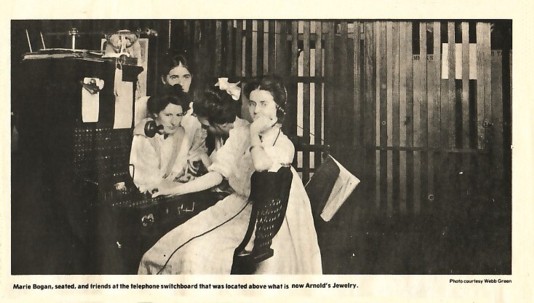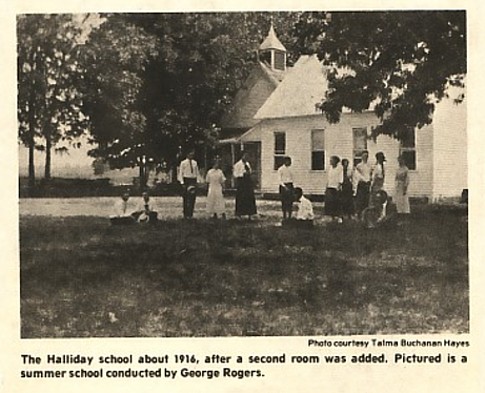I
remember my first day at school.
I waited until I was 7 years old to
start school so that Edna Mae, who
was a year younger than I, could go
with me. Our father went with us that first day and remained at the
school until the morning recess.
Just before noon, Edna Mae missed her father and began to cry. C.
E. Richardson, the teacher, asked her why she was crying. Edna Mae
replied, "I want Papa."
Then I began to cry. Mr. Richard-
son let Edna Mae have his watch to
play with so that she would stop
crying.
As were most of the school buildings of that day, Old Bethel was a
one-room building. The only
========================
Dead Timber
My mother and father, William Preston Goins and Lydia Elizabeth
Lafferty Goins, came to Greene County in three covered wagons from
Orange County, Ill. The trip took three weeks. They must have come in
the fall of 1884. Pa was donated -- homesteaded -- 160 acres of land in
Cache Bottoms in 1896. His heirs still own this land.
My parents moved to the donation on year and one month before I was born
in January, 1897. Our nearest neighbors lived three-fourths of a mile
from us on what are now the Commissary and Beech Grove roads. It was
actually quite a distance and quite a bit of trouble to visit any of
these neighbors, as we had to travel across and around so much water.
The area of land called "Dead Timber," which was one of the 40
acres Pa was donated, was between our house and the hills. This was a
mushy land which would sink in spots. The beavers had dammed up Sugar
Creek which caused water to stand for so long that the large timber all
died, thereby giving "Dead Timber" its name. Stock occasionally got
caught in it and died. If they were found in time, Pa would lariat them
and then take a team or horse and pull them out.
My folks lived there three years before they saw anyone come across
"Dead Timber" on horseback.
Written by: Pearl Morrow
Submitted by: Inez Clark
pupils. Each desk was long enough to accomodate two pupils. In the front of the room were also two long "recitation benches" where each class was seated when the time came to recite that lesson.
The entire back end of the inside of the room was painted black to a
height of about six feet. This was the only chalkboard. Slates were used by the pupils while at their seats and it was a real thrill to be sent to the blackboard to do an arithmetic problem -- that is, if you were able to do the work. Other-wise, it could be the cause of real embarrassment.
One teacher taught all the grades,
one through eight. There were usually 40 to 50 pupils in attend-ance, varying in ages from 6 to 21 years. Beginners were taught to read with the aid of McGuffey's Chart. This chart had the alphabet printed on page one, and pupils were required to learn it first. On
each of the following pages was a picture with a few simple sentences describing it. When the lesson was
learned, that page was turned over
and a new lesson was then showing.
In addition to the chart, these are
some of the texts used: McGuffey's
Readers, Ray's Arithmetic, Barnes
History, Murrey's Geography, Overton's Physiology, Reed and Kellog's Grammar, Shin's Civil Government and Reynold's Arkan-sas History.
Many years later, while my father
was school director, the old one-room building was moved and a two-room building was erected in its place. And several years later I returned to this two-room school -- not as a pupil, but as a teacher.
I last saw the old one-room building in about 1925. It was then in the north-east corner of the school ground. I found my initials along with many others, in the wooded siding of the building.
Old Bethel School District com-bined with several others to form Greene County Consolidated District No. 1. A church now occupies the place where the building once stood and what was
once a playground for happy children is now a cemetery. The only thing that has survived is the catalpa shade tree.
And thus it is and has always been:
What the present generation builds,
future generations will raze and re-
place with something better and more modern.
Adrian Diggs

| Marie Bogan, seated and friends at the telephone switchboard
that was located above what is now Arnold's Jewelry.
Photo courtesy: Webb Green
|

|
| Singing at Halliday School We sang this while in Halliday school: Our Happy Home in Arkansas "Tis a pretty little cottage where the grass is ever green And the streamlets from the Boston Mountains flow, Where the mockingbirds do sing 'Til the woods with music ring At my happy little home in Arkansas. Come to se me, neighbor, come along I'll be there to meet you and it's "Ah," 'Tis the finest country found. I will show you all around At my happy little home in Arkansas. We'll go out into the orchard where the fruit is on the trees 'Tis the place where the premium apples grow. They are luscious, mellow sweet You may have all you can eat At my happy little home in Arkansas. We'll go hunting in the mountains, We will bathe in mineral springs, Go and see the big plantations down below. Show your cotton, show your cane. Show your every kind of grain At my happy little home in Arkansas. Talma Buchanan Hayes Flint, Mich. |
Lamplight, torn hymnals Some of my most pleasant memories are of the New Hope Baptist Church -- a small, one-room wood frame building. It had a door in front, windows along each side, hard wooden benches to sit on, bare floors, kerosene lamps for light and a large wood-burning stove at about the center of the building. We sang from old, worn songbooks that were torn. Our music came from an old organ that was always out of tune. We had Sunday school in the morning and B.Y.P.U. -- Baptist Young People Union -- at night. We didn't have a preacher, except in summer. People walked to church or came in wagons or buggies. The roads were gravel and dusty. Young children came barefooted. Men wore overalls and white shirts and ladies wore their bonnets. In revivals, the little children slept in wagons, on straw or a quilt. The church is now gone and so are most of the people who attended New Hope Baptist Church. Opal Wood |